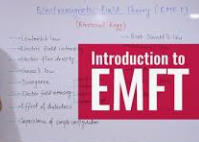EMFT Interview Questions :-
1. Why zigzag kind of feed is used in log periodic antennas?
To minimize the backward radiation (towards the layer elements). The feeding voltage for each element is reversed so that the current flowing in alternative direction in each element, which forms an array factor having minimum in backward direction and maximum in forward direction.
2. What do you mean by Rayleigh scattering?
The glass which is used in the fabrication of fibres has many microscopic inhomogeneities and material density fluctuations of the silica material components. As a result, a portion of light passing through the glass fibres gets scattered. This is known as Rayleigh scattering.
3. What is the difference between scanning and tracking?
Scanning refers to the way in which the antenna keeps moving in azimuth and elevation for covering an area which has the desired target whereas tracking means tracking the path of the target by means of the radar.
4. Can paper effect magnetic flux?
Paper cannot effect magnetic flux because it is not a magnetic material.
5. Why circular polarization is becoming popular these days?
Circular polarization minimizes the clutter echo’s received from raindrops, transmission and reception between artificial satellite and earth etc, so circular polarization is becoming popular these days.
6. What happen when electromagnetic waves are incident on a perfect dielectric?
When electromagnetic waves are incident on a perfect dielectric then waves are partially transmitted and partially reflected.
7. What are the factors for insertion loss in a line between source and load?
Insertion loss in a line between source and load is due to losses in the line, reflection losses at source and load and mismatching between source and load.
8. Why coherent transmission is used instead of non-coherent transmission?
In coherent transmission the spectrum is discrete so energy transmitted is maximum which increases range detection without decreasing range resolution.
9. What is IP3 of an amplifier?
IP3 is a measure of third order intermodulation distortion. It is the interception point on the output power versus input power diagram where the third order intermodulation product gain curve meets the signal gain curve.
10. How do you place a ring antenna over a ground plane if you want to use it as the reflector?
Vertically, half wavelength above ground. Since the equivalent magnetic dipole and its image will be in phase and radiate maximum along the direction normal to the ground.

11. What do you mean by transverse nature of electromagnetic waves?
For a electromagnetic waves E and H are perpendicular to each other and both are perpendicular to the direction of propagation. That’s why electromagnetic waves are known as transverse electromagnetic (TEM) waves.
12. What are degenerative modes?
The modes having same cut-off wavelength, but different field pattern are called degenerative modes.
13. What is dominant mode?
The dominant mode is characterized by the wave having highest cut-off wavelength.
14. What are the advantages of using optical fibres?
The advantages of using optical fibres are as follows-
- Superior transmission quality.
- Higher information carrying capacity.
- Light weight and smaller size.
- Reduced cost and higher security.
- Immune to electromagnetic interference and radio frequency interference.
- It has larger bandwidth.
- A material used in fibres is silica glass or silicon oxide which is one of the most abundant materials on earth.
15. What do you mean by dispersive medium?
The medium in which the parameters of the medium affecting wave propagation through it vary with frequency is called dispersive medium.
16. When the polarization is said to be elliptical?
When the components EX and EY of unequal amplitudes have a constant, non-zero phase difference between two, for a uniform plane wave travelling in Z-direction, the polarization is elliptical.
17. What is skin depth or depth of penetration?
The distance through which the amplitude of the travelling wave decreases to 37% of the original amplitude is called skin depth or depth of penetration.
18. What are supermagnetic materials?
In supermagnetic materials, the ferromagnetic materials are suspended in the dielectric matrix. The important property of the supermagnetic material is that even though each particle of it contains large magnetic domains but cannot penetrate adjacent particles.
19. What do you mean by boundary conditions?
The conditions existing at the boundary of the two media when field passes from one medium to other are called boundary conditions. Depending upon the nature of the media, there are two situations of the boundary conditions.
- Boundary between conductor and free space or boundary between conductor and dielectric.
- Boundary between two dielectrics with different properties.
20. Explain relaxation time with an example?
Imagine that you have a solid metal ball or sphere and you place a charge inside of it. This charge will arrive at the surface as a surface charge. How fast this charge arrives at the surface can be calculated using the term relaxation time.
21. What is drift velocity and how it relates to the electric field intensity?
In free space the electrons would accelerate and their velocity continuously increases in the material. The progress of the electron is hindered by regular collisions with the thermally excited crystalline lattice structure and a constant average velocity is soon attained. This velocity is known as drift velocity and it is directly proportional to electric field intensity in the given material.